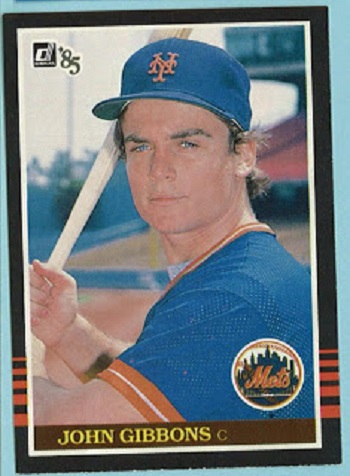Man, that Gibbons can run ... 55 yards
* John Gibbons former high school coaches at Gen. Douglas MacArthur High showed in Florida for a vacation and to tell some stories about their protege. ....
2014 Canadians in the Minors … Canadians in College …. All-Canadian Team 2015 Canadian draft list …. Canadians in College 2016 Canadian draft list Letters of Intent
By Bob Elliott
CLEARWATER _ There were plenty of coaching legends at Bright House Field on Saturday afternoon.
Larry Bowa, Juan Samuel and Charlie Manuel were in the Philadelphia Phillies dugout.
And cheering for the Blue Jays were coaching legends Syl Perez and Frank Arnold.
What’s that?
You don’t know the names Perez and Arnold?
Perez coached the Gen. Douglas MacArthur High Brahamas in San Antonio who had a catcher named John Gibbons.
Arnold coached the football Brahamas with a running back/blocking back by the same name.
Perez was heavily involved helping Gibbons through the draft process remembering the spring of 35 years ago when “we had more scouts than fans at our games.”
The San Antonio coaches were in Florida to see Gibbons ... and tell stories.
Like the time Cincinnati Reds scout Joe Caputo showed to clock Gibbons in the 60-yard dash.
“Coach ... do me a favor, pace off 60 for me will you please,” Caputo asked Perez.
Caputo paced and eventually off Gibbons sped.
“Dang, that boy can run!” said Caputo looking at 6.8 seconds on his stop watch.
Perez laughed telling the story.
“I didn’t say anything until after the draft, I stopped pacing at 55 yards,” said Perez, who brought his sons Mickey and Steve Perez on the trip.
A Los Angeles Dodgers scout called Gibbons at home one night telling him how to change his approach at the plate. Gibbons called Perez.
Perez wrote a letter to the Dodgers and Perez said that the Dodgers apologized.
The first scout Gibbons ever met was Al LaMacchia of the Jays.
“He was behind me in the bullpen and when our pitcher finished he said ‘son, know how many balls you dropped? Five. You better work on that,” Gibbons said. “I asked who was that?”
Perez told of the headline in the San Antonio Light which read something like ‘Grote and Ryan, Now Gibbons and Godden?’after the New York Mets drafted Gibbons.
MacArthur grad Jerry Grote played 16 years in the majors, 12 with the Mets.
“Grote told me with tough left-handed hitters he’d throw the ball back to the pitcher past the hitter’s nose,” Gibbons said. “He’d do it a second time, the guy would turn and say ‘once more and we’re fighting.’ He said they didn’t fight but he’d distracted the guy enough to where he didn’t get any hits.”
 The Gibbons and Gooden headline never appeared on the back page of the New York Post. Gibbons was injured in a home-plate crash late in 1984 and when he returned New York had acquired Gary Carter from the Montreal Expos. Gibbons started only 14 games for the Mets before coaching and managing.
The Gibbons and Gooden headline never appeared on the back page of the New York Post. Gibbons was injured in a home-plate crash late in 1984 and when he returned New York had acquired Gary Carter from the Montreal Expos. Gibbons started only 14 games for the Mets before coaching and managing.
Perez said Gibbons’ father was a dream parent for a coach: “Bill used to sit down the right field line ... never said a word to our coaches.”
Hall of Fame general manager Pat Gillick, who scouted Gibbons, called him “one of the most energetic catchers,” he’d seen. The Jays took infielder Garry Harris second over all (he peaked at double-A Knoxville) and Ken Kinnard in the second (he played two games at triple-A Syracuse).
“John hit .190 as a junior with a double,” said Arnold, although Gibbons thought he had two homers. “His draft year he hit .500 with 10 homers in 19 games -- 19 games was our schedule back then.”
Perez told of making a phone call to Coach Gus.
“Full ride,” said Texas Longhorns coach Clint Gustafson, when Perez finishes with his story.
When the mighty baseball Brahamas made the playoffs, two-sport players, like Gibbons, still had to make coach Arnold's morning workouts for spring football in the field house.
“They’d lock the doors, turn up the heat and do agility drills,” said Gibbons. “You were beat in the morning and still had a game to play. “Times were different then.”
When report cards came out Arnold was there to check anyone for a failing grade or poor conduct in class.
“For either they’d tell you to go line up over there ... you didn’t want to be in that line,” said Gibbons, who said he never made the disciplinary queue.
Once Arnold was admonishing a player and the linebacker swung at the coach. Perez rushed to the rescue.
Mets legendary Texas area scout Jim Hughes, who later worked for the Jays, drafted Gibbons 24th over-all. His initial offer was $45,000 US.
“Hughes didn’t say a lot, but said the Mets couldn’t go much higher,” Gibbons remembered. “After his visit I said to my dad maybe they won’t sign me. We called Hughes’ hotel and asked ‘will you pay $55,000?’ Hughes said ‘Be right over.’”
New York chose Darryl Strawberry first over-all in North America and Billy Beane 23rd.
“They both held out over a month, Darryl got more than $200,000, Billy more than $100,000,” Gibbons said. “I asked Darryl what his initial offer was ... $45,000.
“They signed Jay Tibbs in the second and gave him $90,000.”
Gibbons bought a new car, a Mazda 280ZX and invested the rest.
The first call he received from New York was from legendary PR maven Jay Horwitz to set up a conference call with writers.
And Horwitz is still there in Flushing making phone calls to No. 1 picks.
Of the Mets first four picks in 1980 only Beane, general manager of the Oakland A’s, and Gibbons remain in the game.